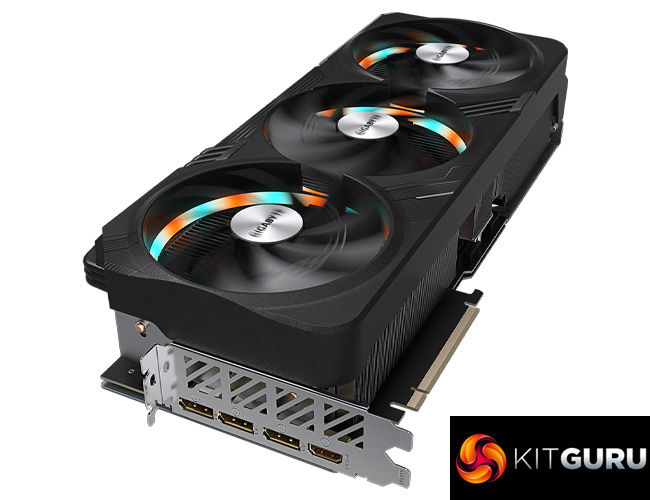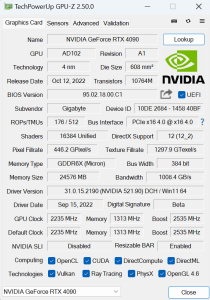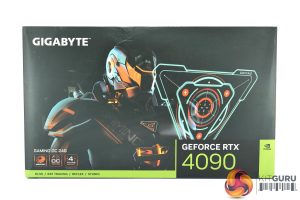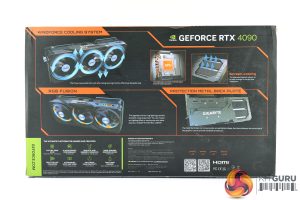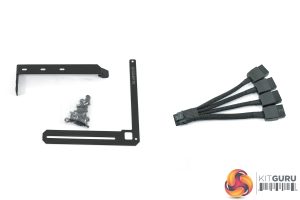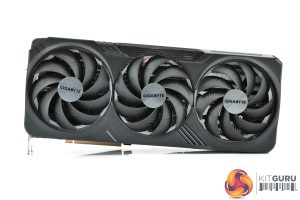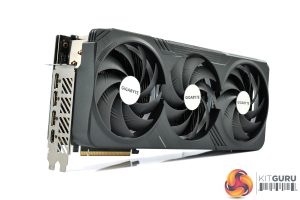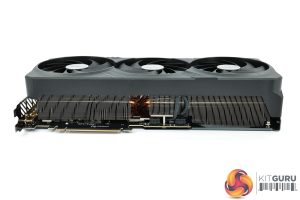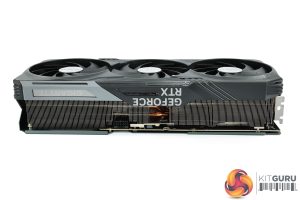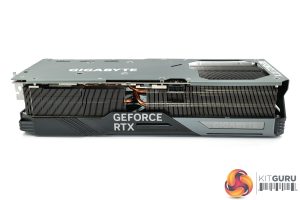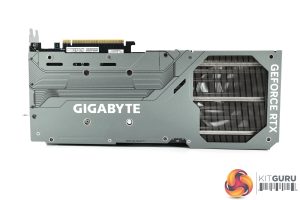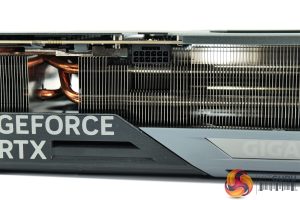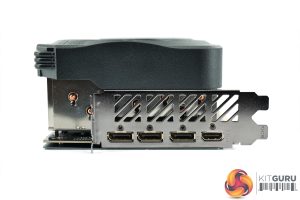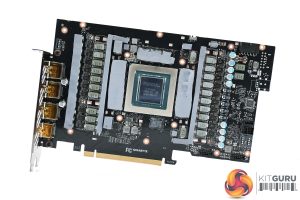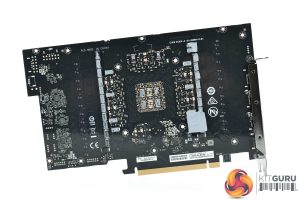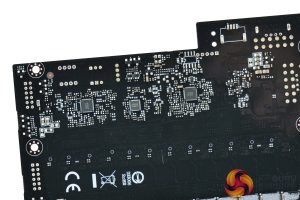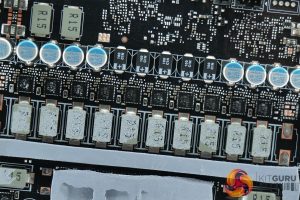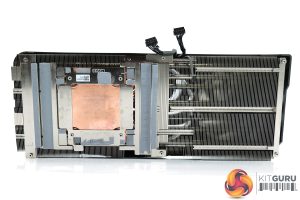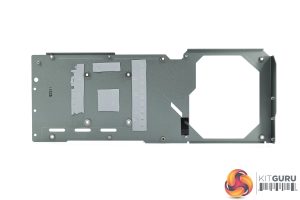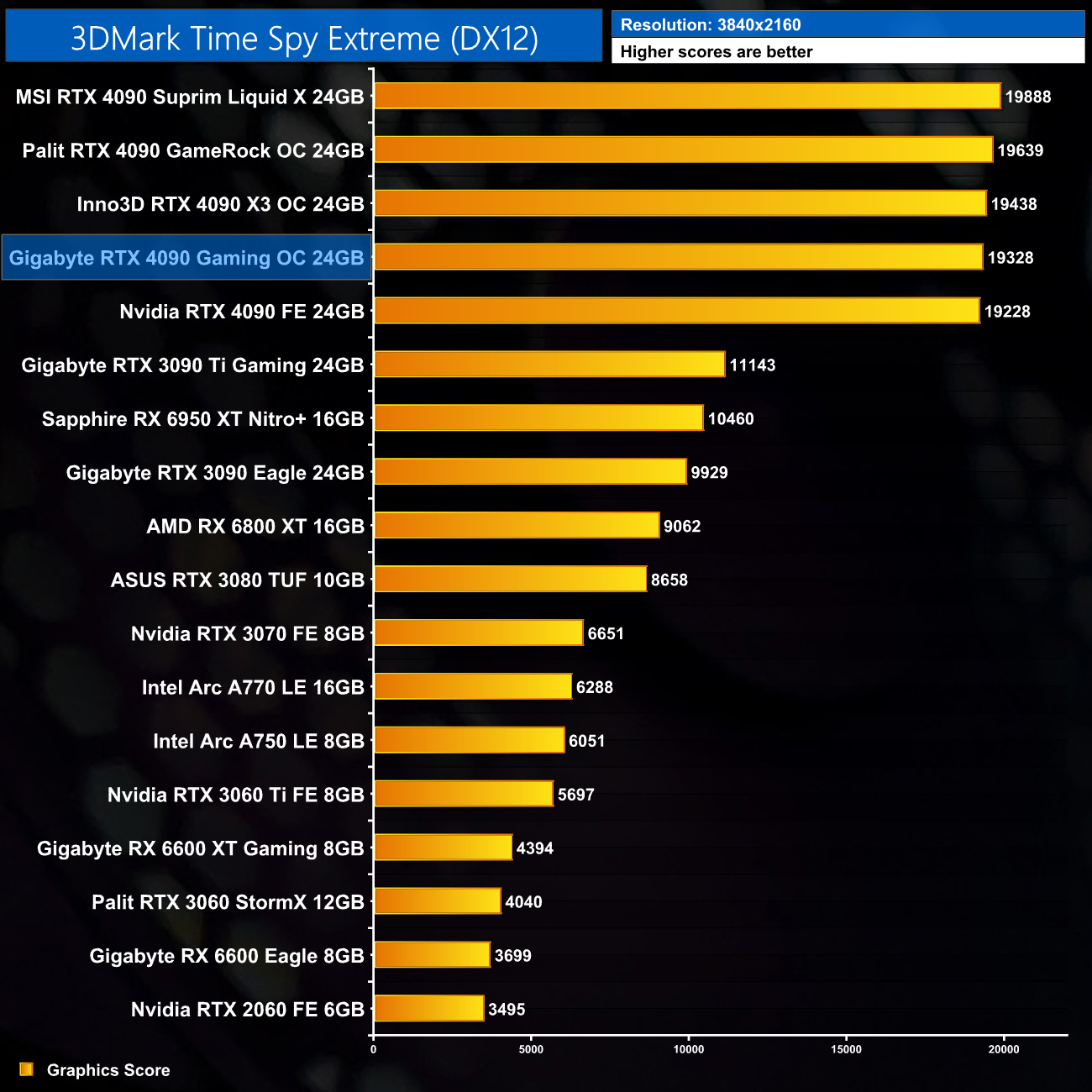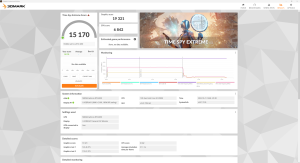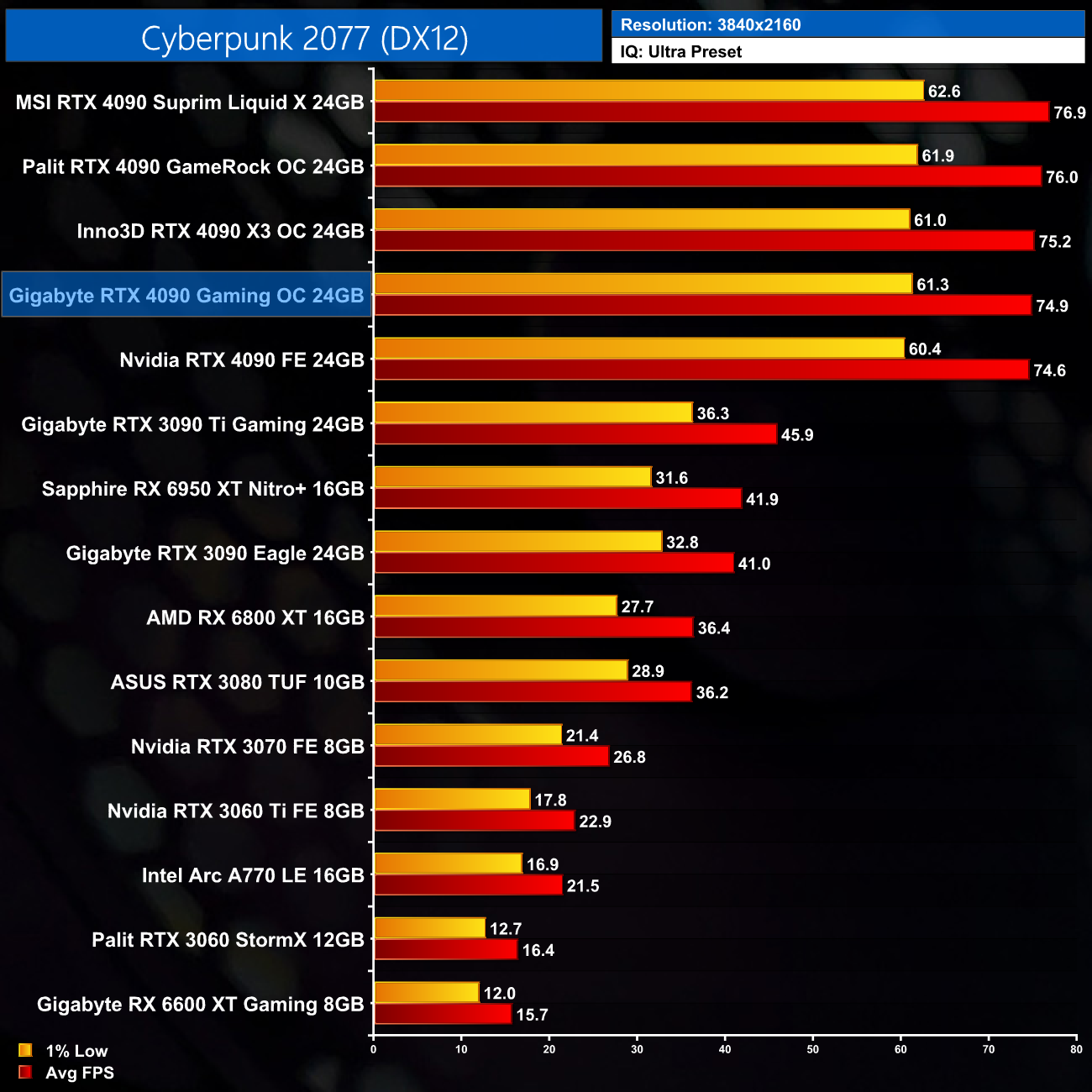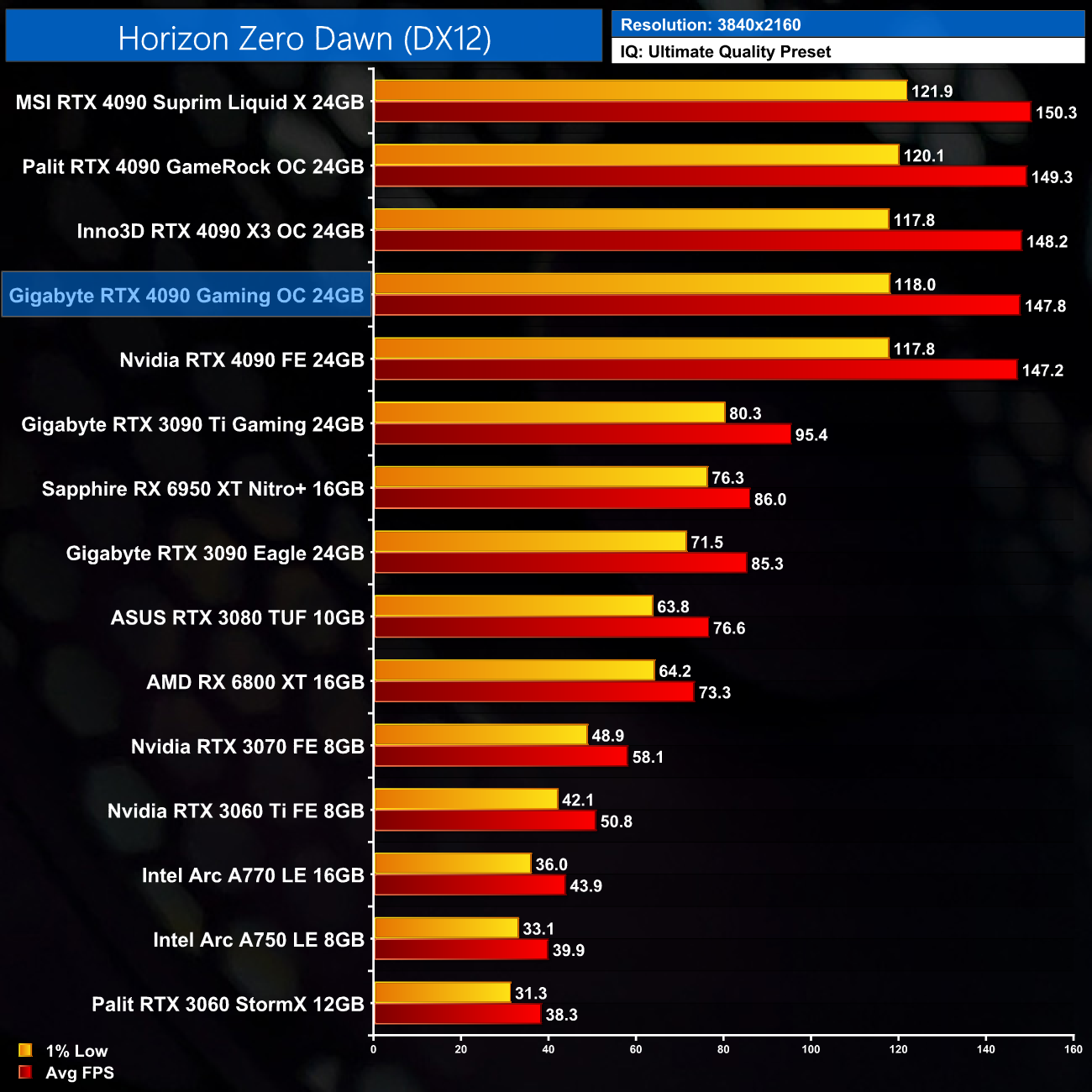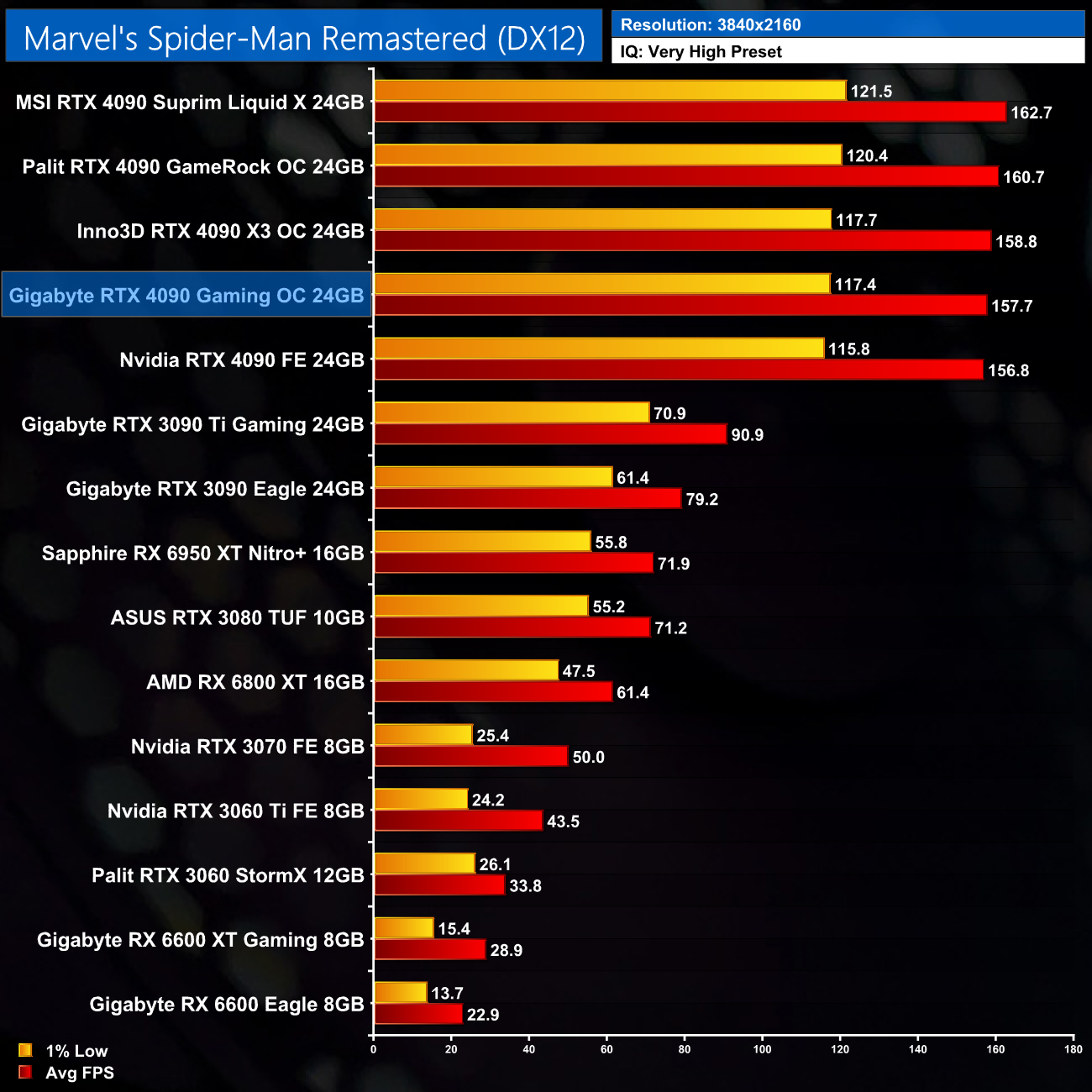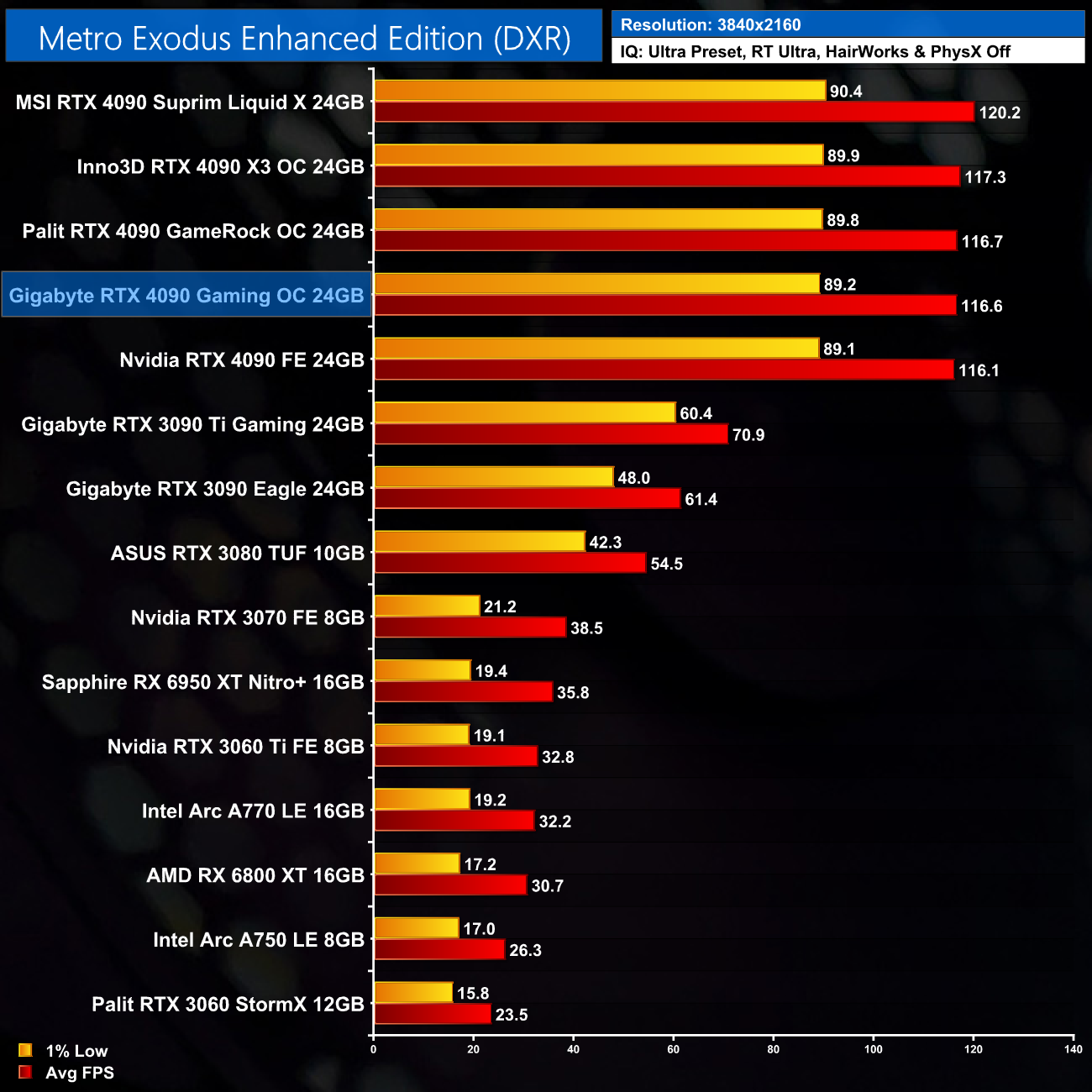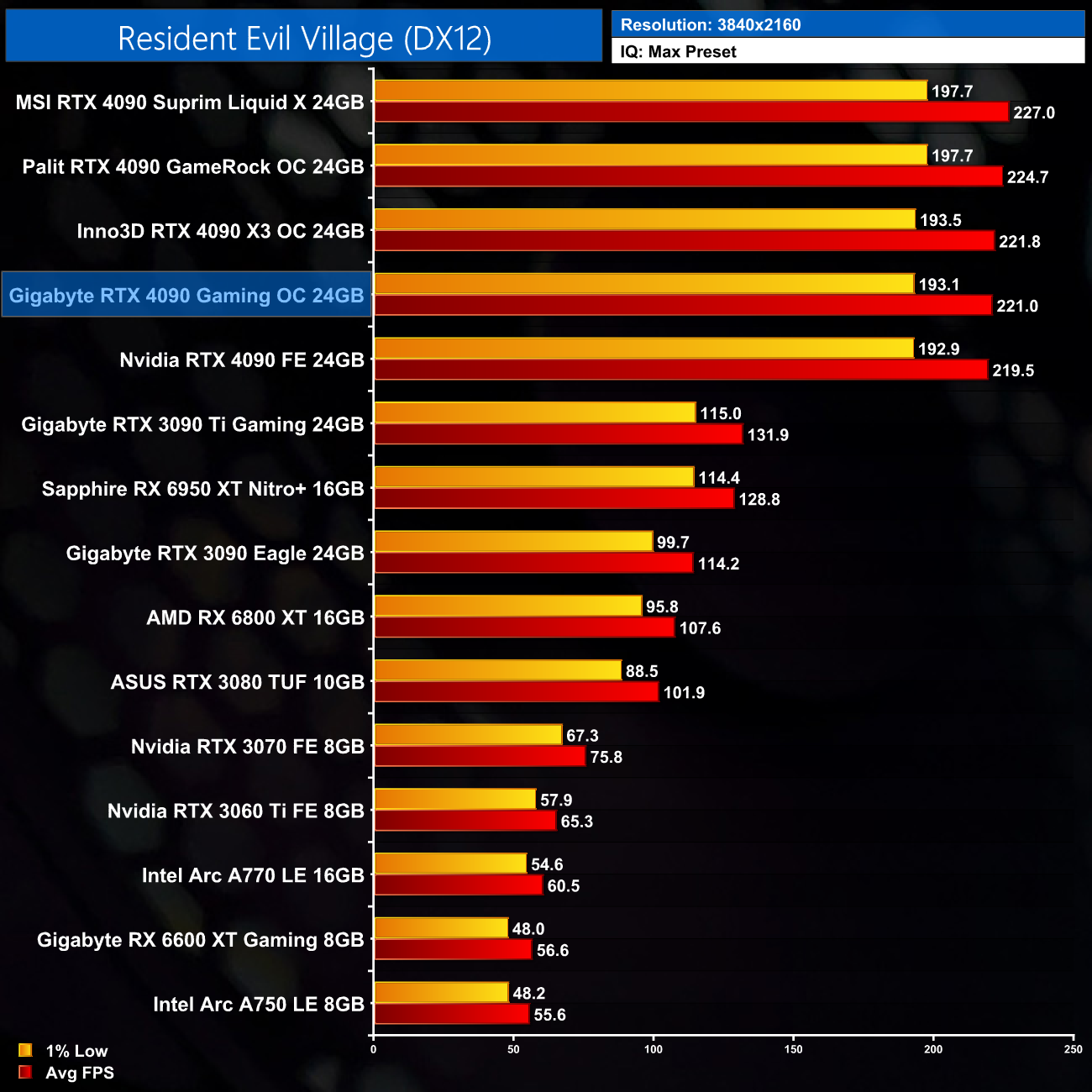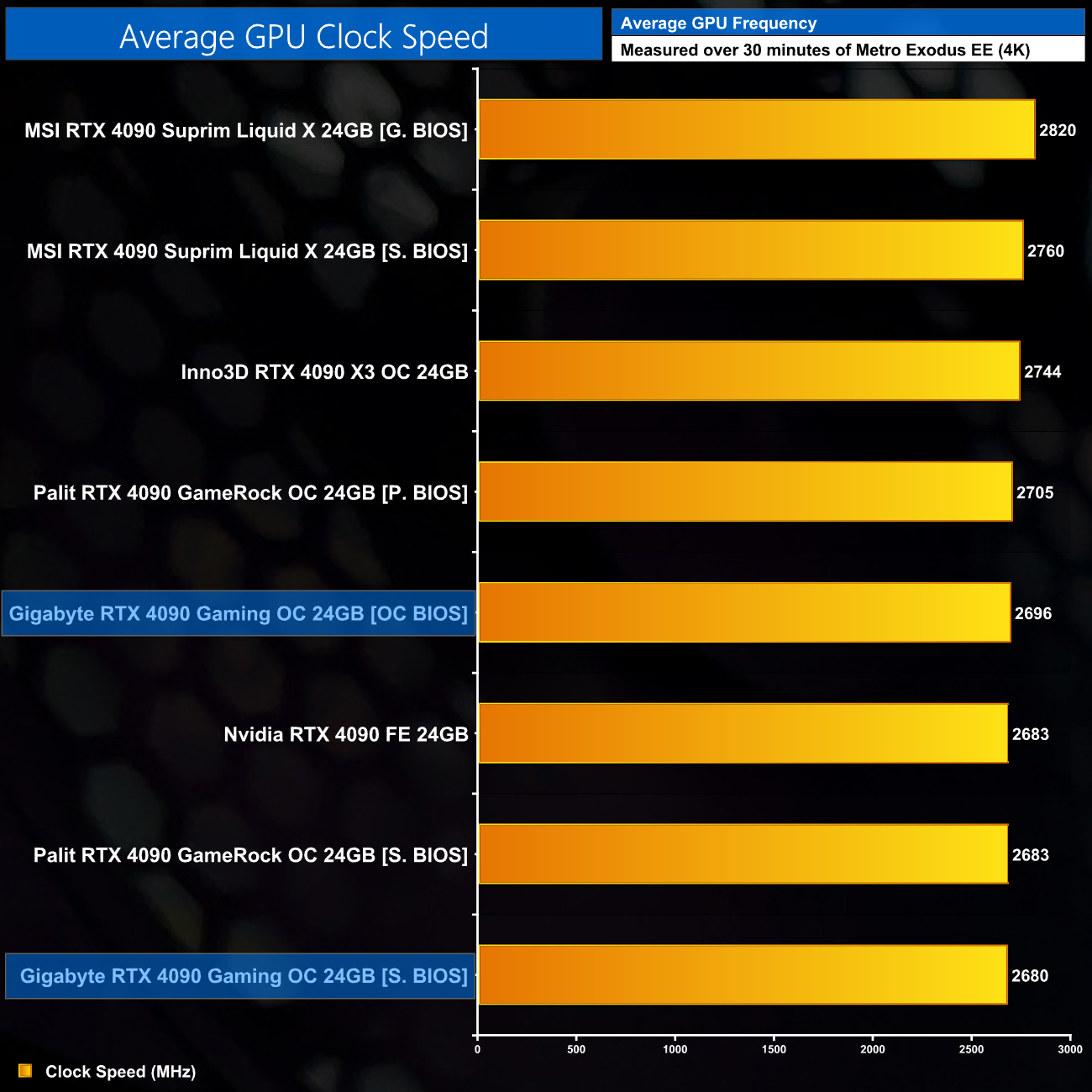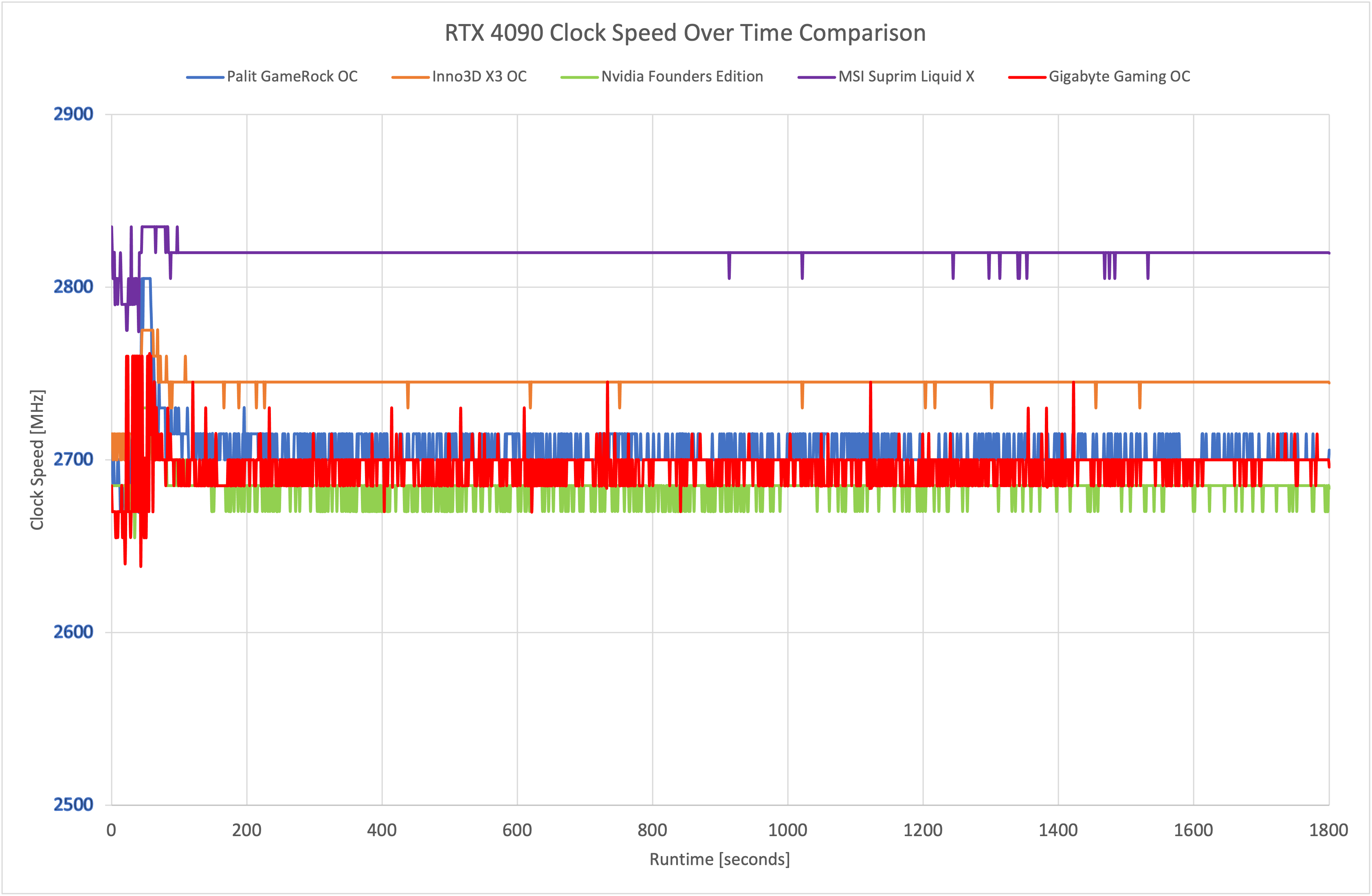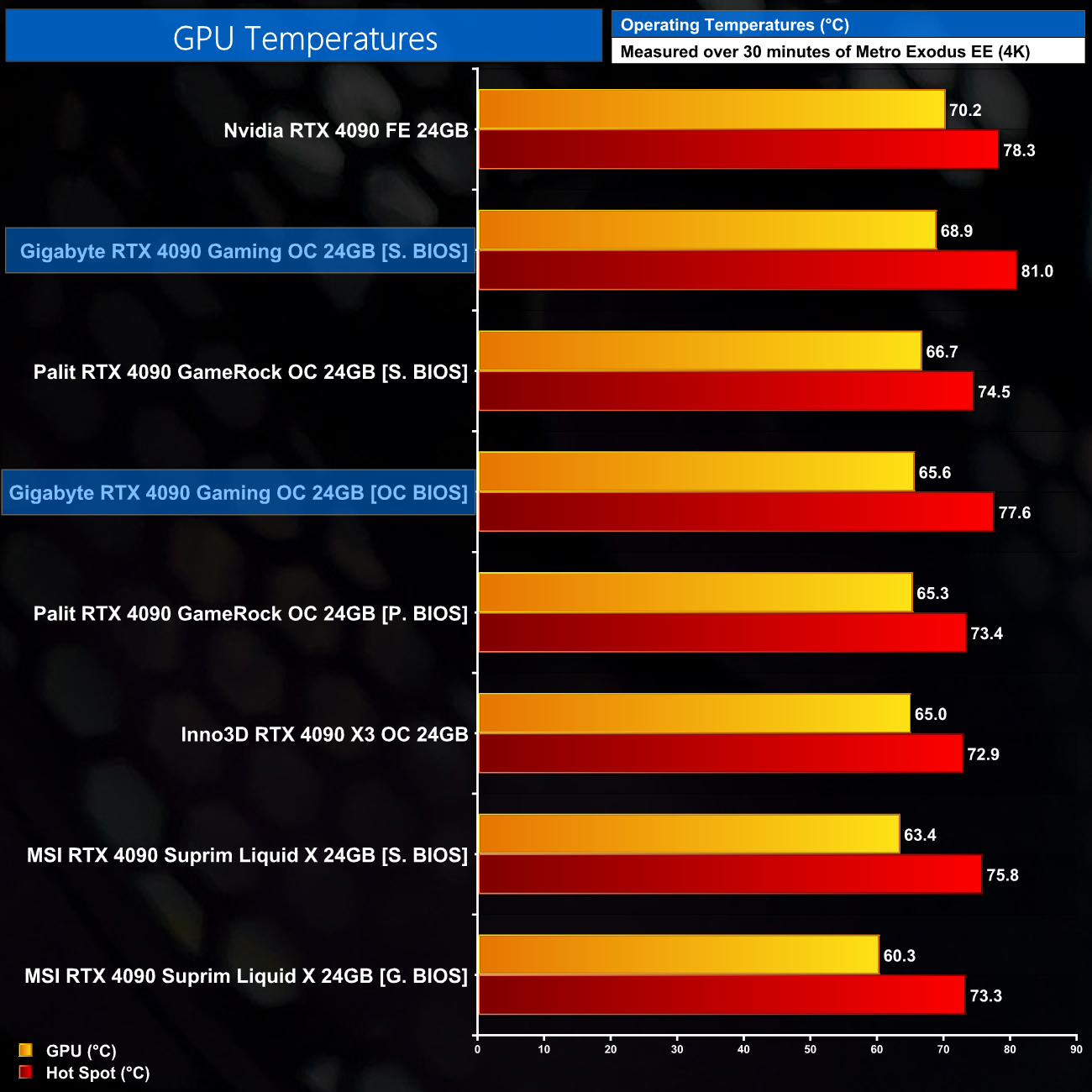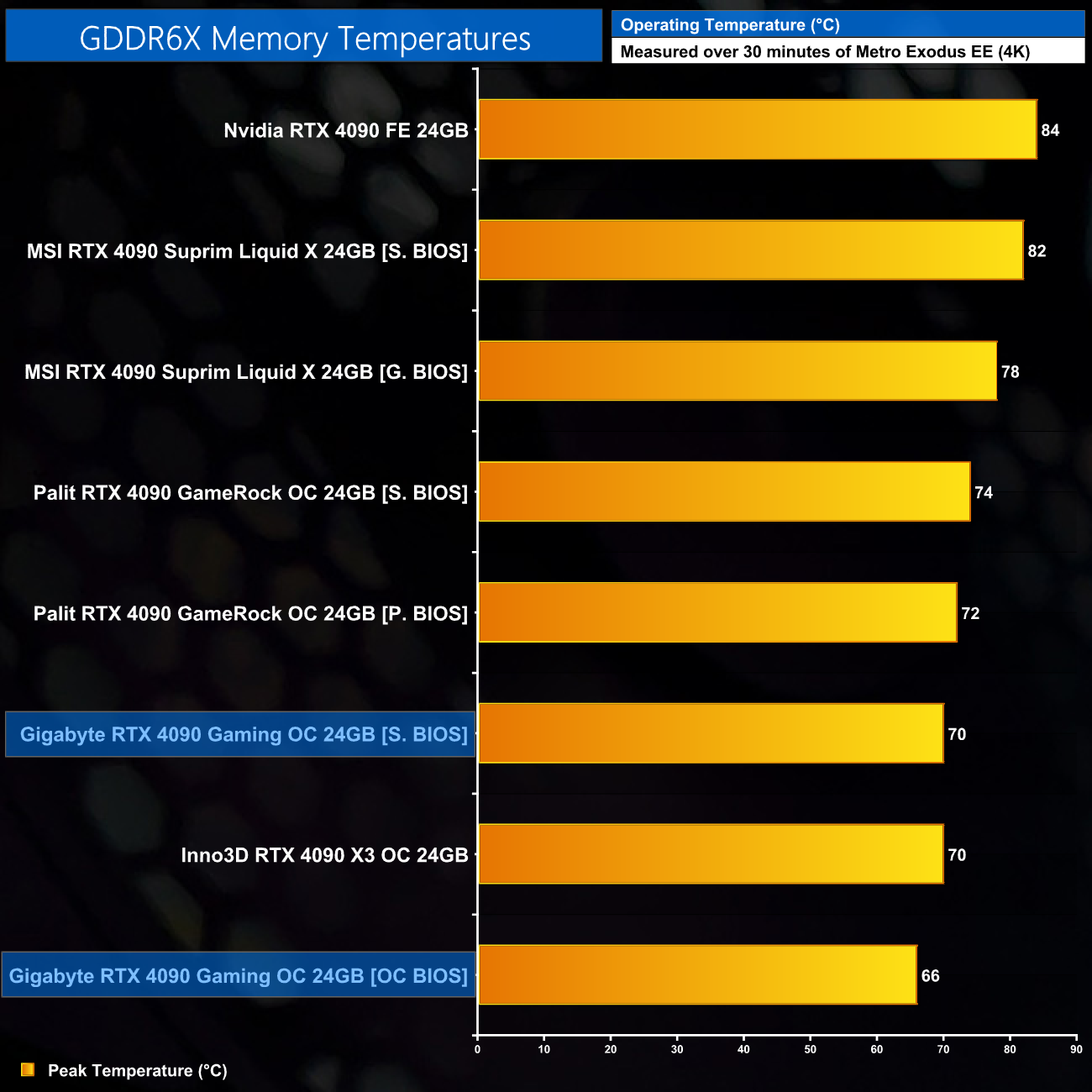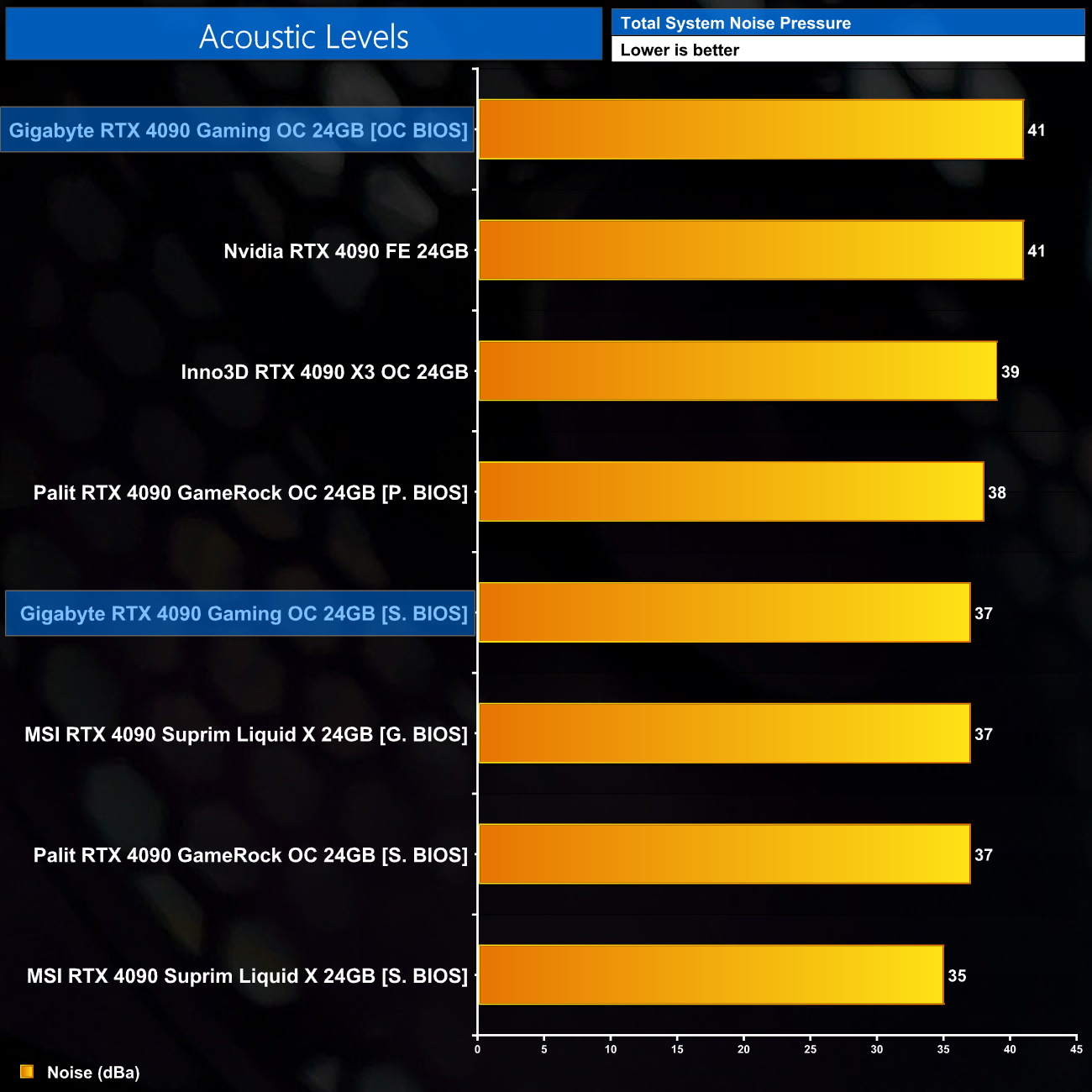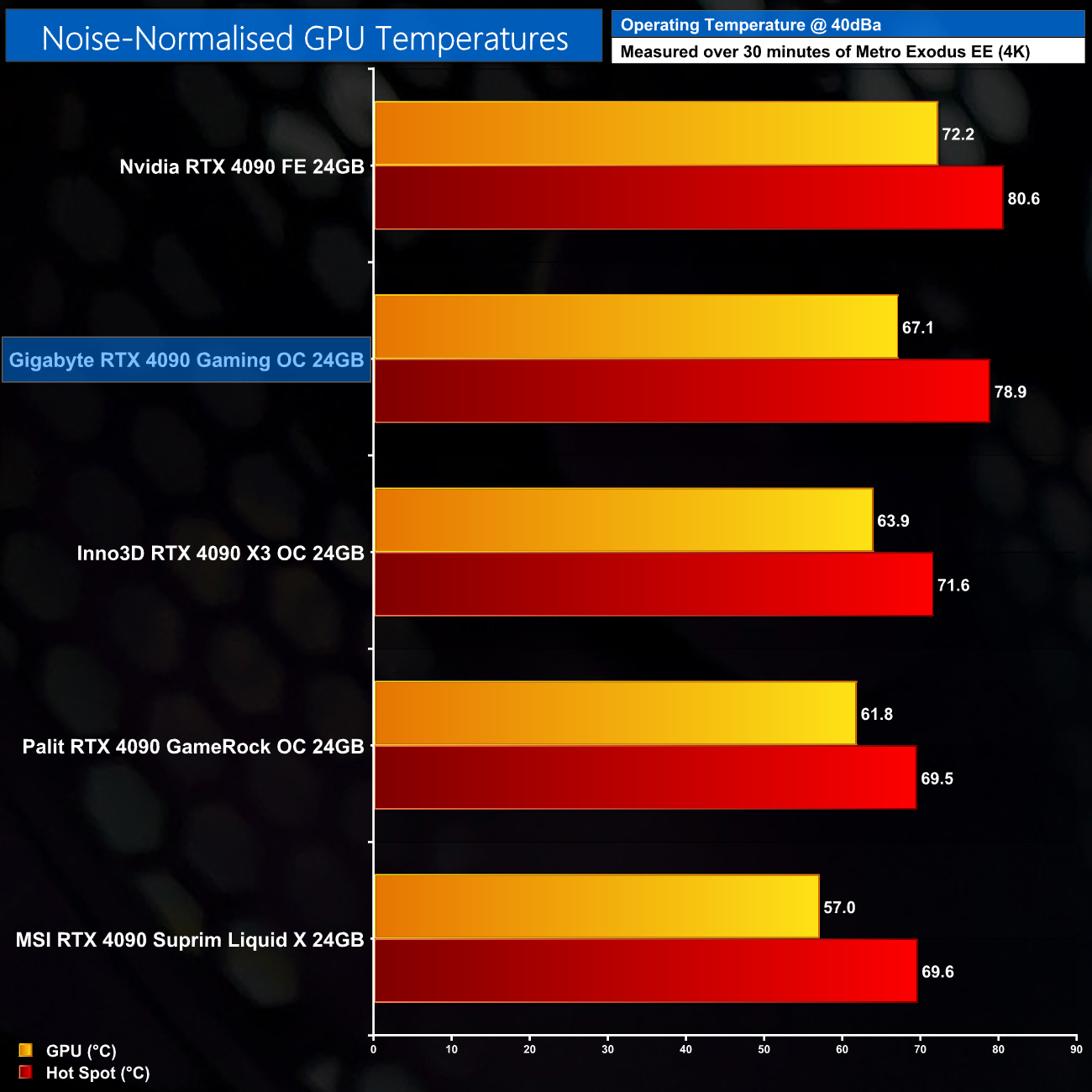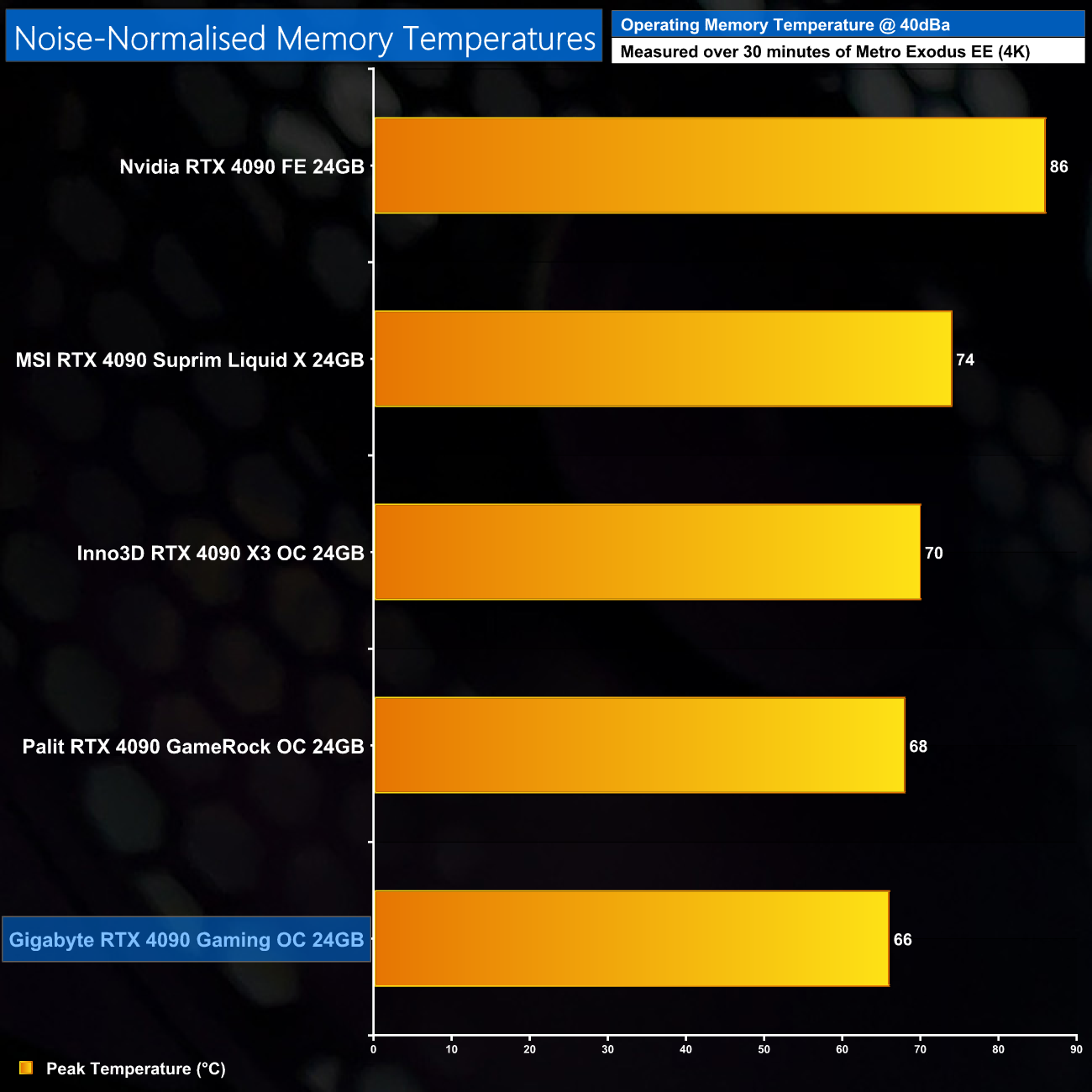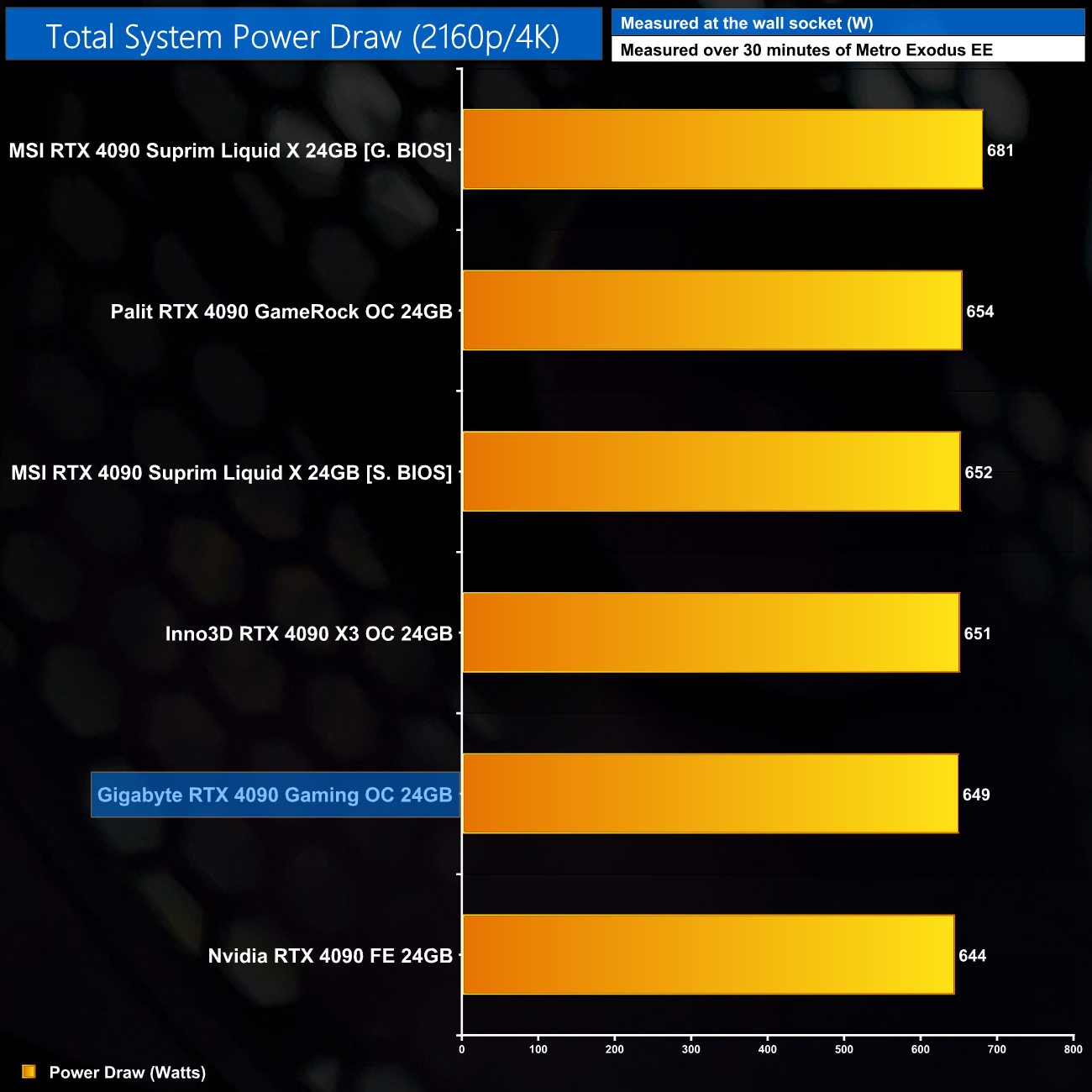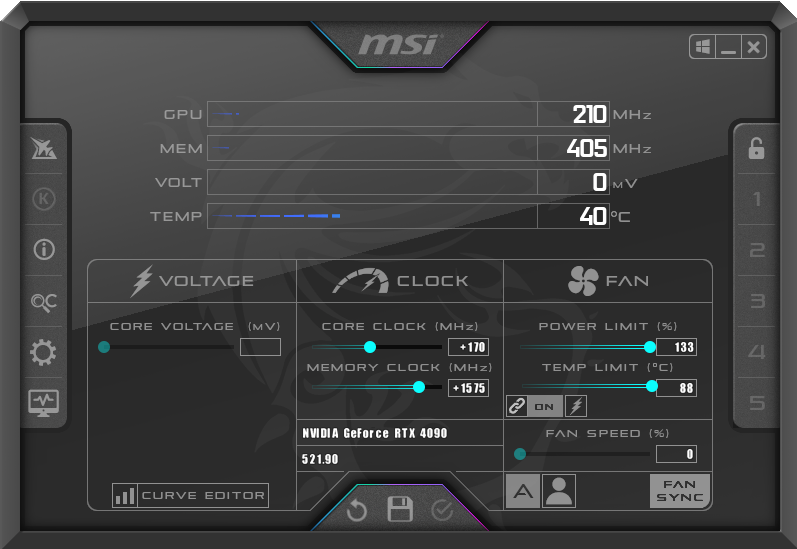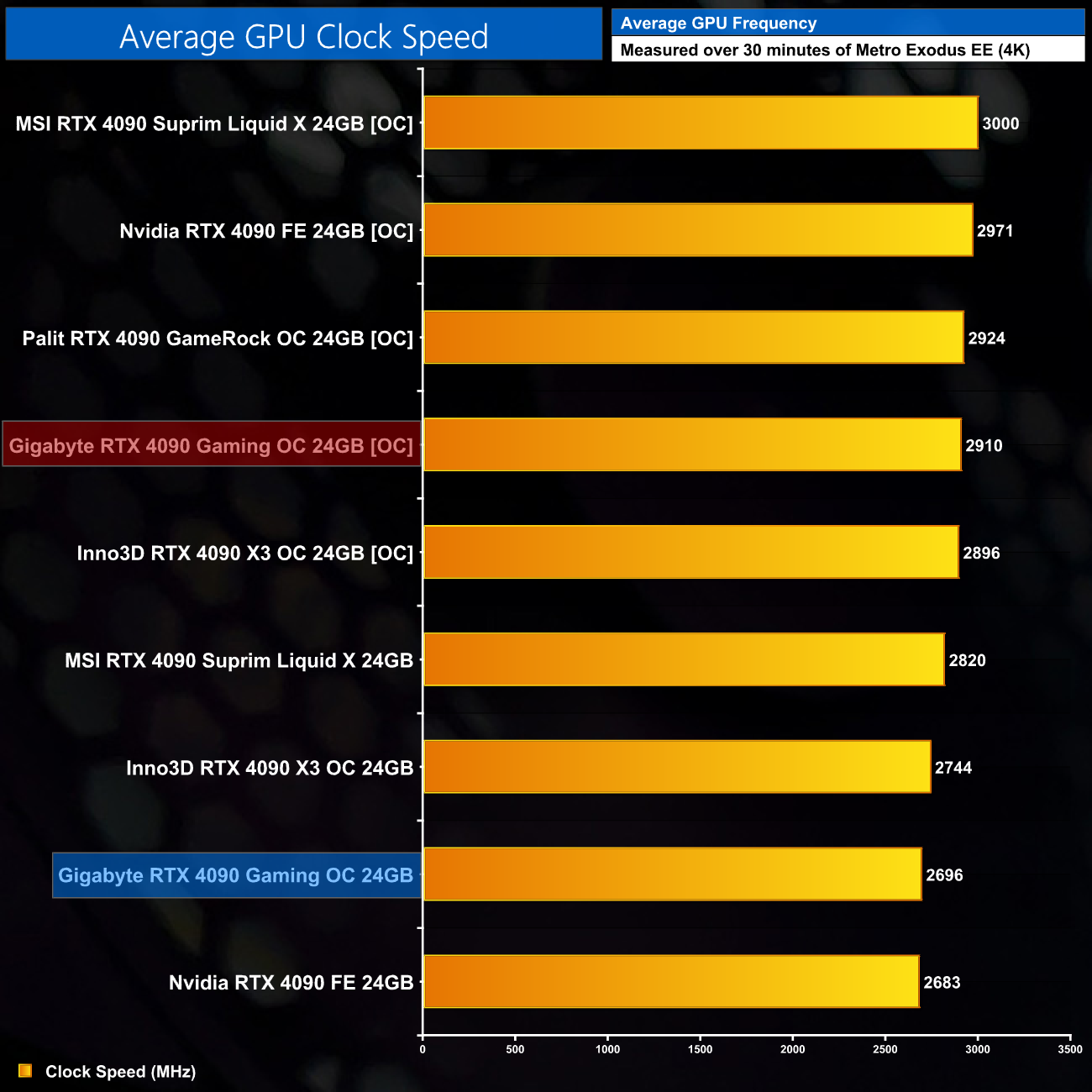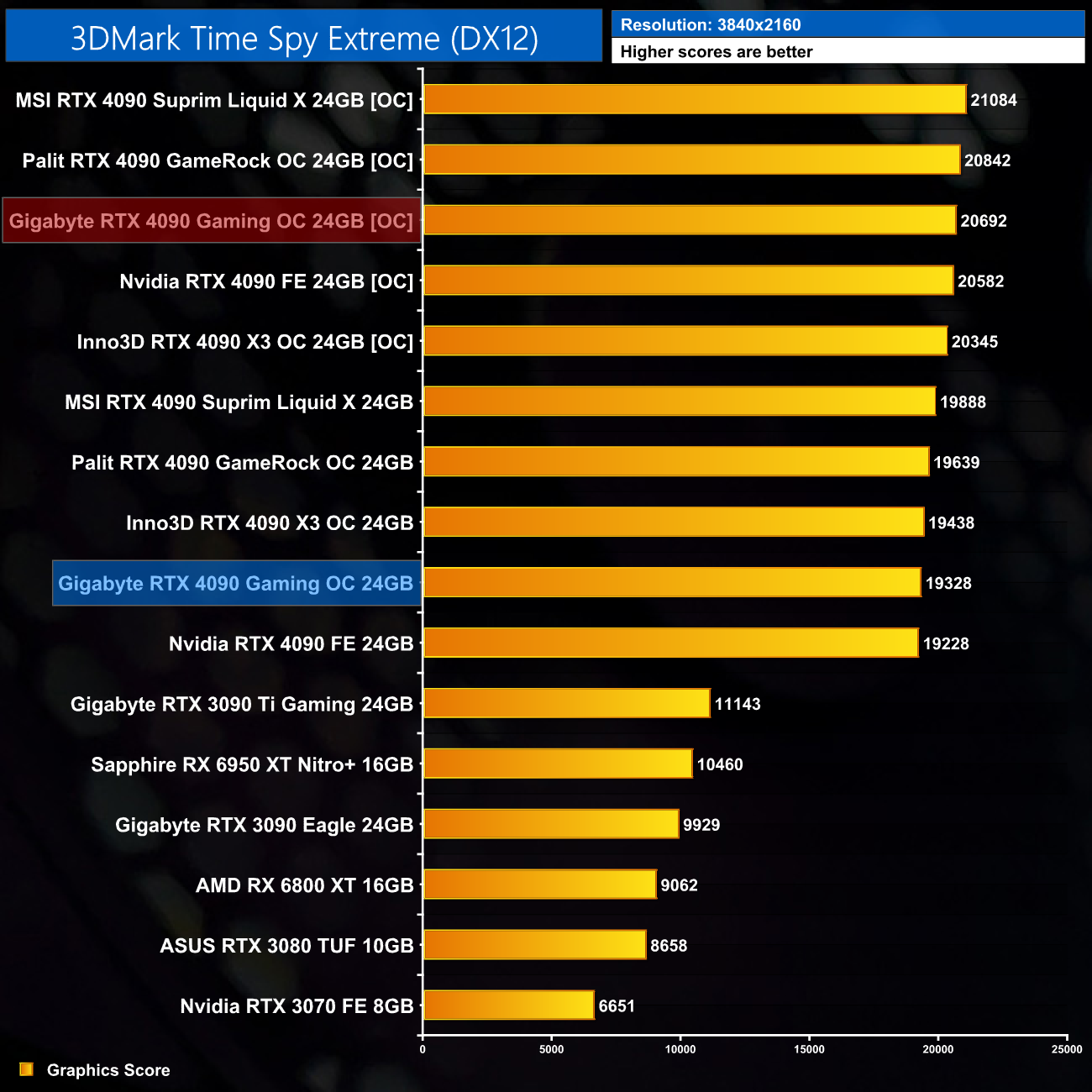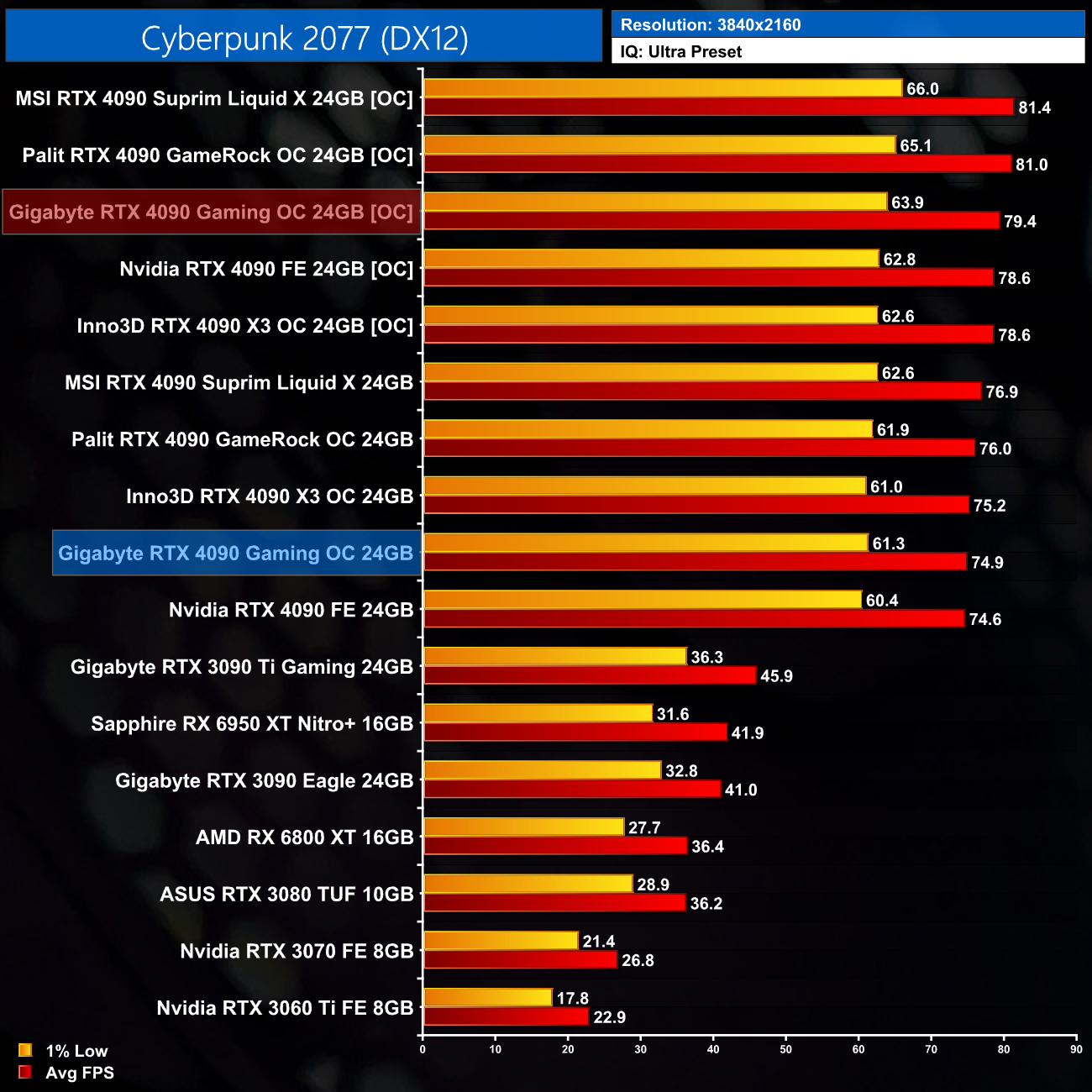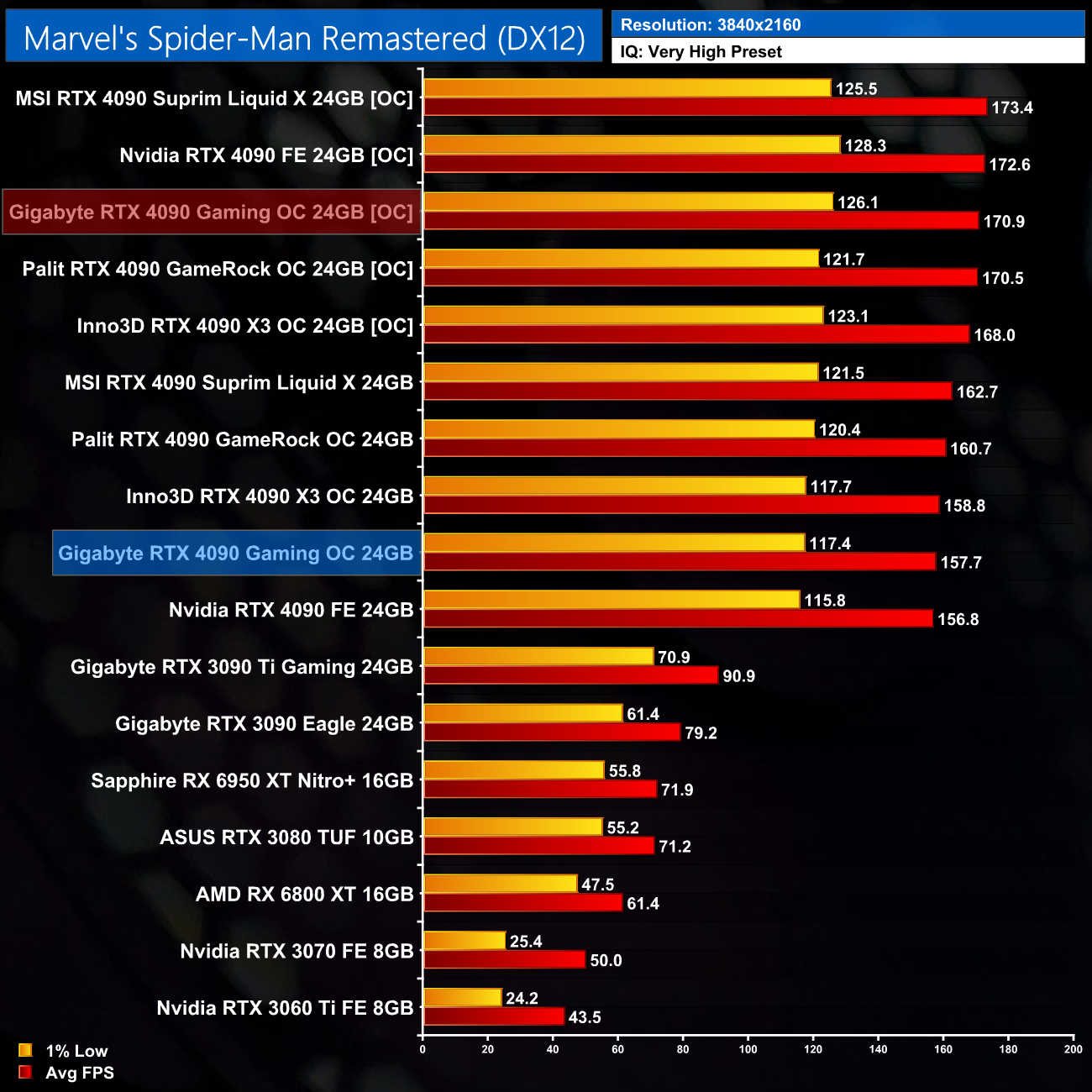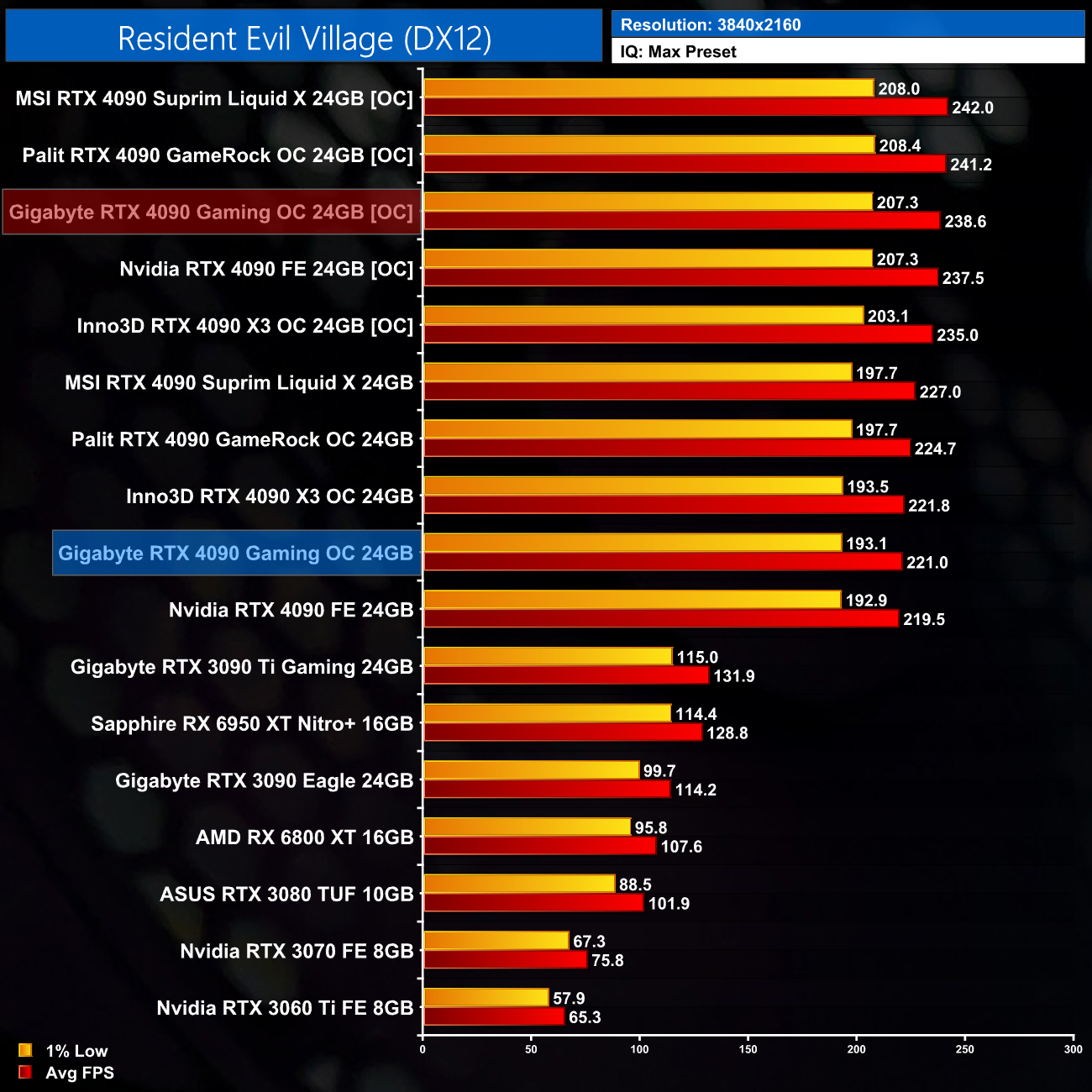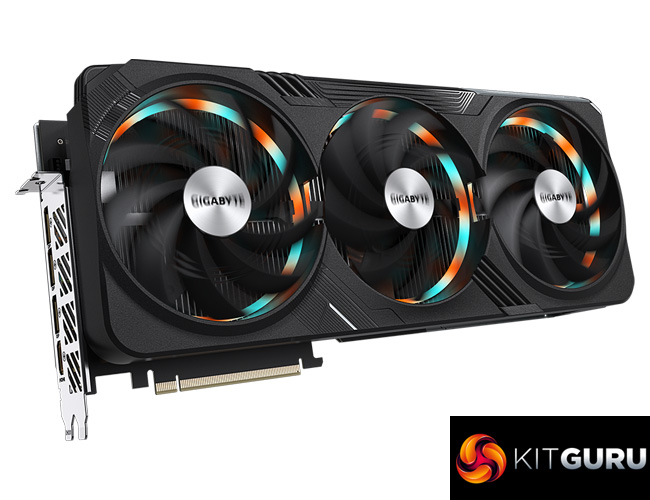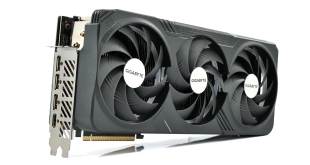
With our fifth RTX 4090 review, today our attention turns to the beast that is the Gigabyte Gaming OC model. Offering a huge, quad-slot cooler, dual-BIOS, and a power limit that can hit up to 600W when overclocking, there's certainly a lot to like about this card on paper. We put the Gaming OC through its paces and see how it stacks up against the competition.
While our previous RTX 4090 review assessed the liquid-cooled MSI Suprim Liquid X, today we take a look at a huge air-cooled card in the form of the Gigabyte RTX 4090 Gaming OC. Despite its gargantuan size, the Gaming OC only offers a 15MHz factory overclock versus the reference spec, so it will be interesting to take a closer look at clock speed behaviour in this review.
Alongside the choice of either the OC or Silent BIOS, Gigabyte also offers gamers a smattering of RGB lighting, a metal backplate and a vapour chamber cooler, so without further ado, let's get into the nitty gritty…
| RTX 4090 | RTX 3090 Ti | RTX 3090 | RTX 3080 Ti | RTX 3080 | |
| Process | TSMC 4N | Samsung 8N | Samsung 8N | Samsung 8N | Samsung 8N |
| SMs | 128 | 84 | 82 | 80 | 68 |
| CUDA Cores | 16384 | 10752 | 10496 | 10240 | 8704 |
| Tensor Cores | 512 | 336 | 328 | 320 | 272 |
| RT Cores | 128 | 84 | 82 | 80 | 68 |
| Texture Units | 512 | 336 | 328 | 320 | 272 |
| ROPs | 176 | 112 | 112 | 112 | 96 |
| GPU Boost Clock | 2520 MHz | 1860 MHz | 1695 MHz | 1665 MHz | 1710 MHz |
| Memory Data Rate | 21 Gbps | 21 Gbps | 19.5 Gbps | 19 Gbps | 19 Gbps |
| L2 Cache | 73728 KB | 6144 KB | 6144 KB | 6144 KB | 5120 KB |
| Total Video Memory | 24GB GDDR6X | 24GB GDDR6X | 24GB GDDR6X | 12GB GDDR6X | 10GB GDDR6X |
| Memory Interface | 384-bit | 384-bit | 384-bit | 384-bit | 320-bit |
| Memory Bandwidth | 1008 GB/Sec | 1008 GB/Sec | 936 GB/Sec | 912 GB/Sec | 760 GB/Sec |
| TGP | 450W | 450W | 350W | 350W | 320W |
First, for a quick spec recap. Using TSMC's 4nm node has allowed Nvidia to vastly increase transistor count, up from 28.3 billion with GA102, to a staggering 76.3 billion with the largest Ada GPU, AD102. Accordingly, core count has gone through the roof, with the RTX 4090 home to 16384 CUDA cores, with 512 Tensor cores and 128 RT cores, with a sizeable increase to the ROP count too, up to 176.
Such a leap forward in process node has also allowed Nvidia to crank the clock speed significantly, with the RTX 4090 now sporting a 2520MHz rated boost clock. The Gigabyte Gaming OC we are reviewing today has tweaked that further, adding an extra 15MHz out of the box.
Memory configuration is almost identical to the RTX 3090 Ti, with 24GB GDDR6X running at 21Gbps, operating over a 384-bit interface, totalling memory bandwidth of just over 1TB/s. That said, there has been a substantial upgrade to the L2 cache with the Ada architecture, with the RTX 4090 now offering 73MB, compared to 6MB for GA102.
Power draw also remains at 450W, as per the RTX 3090 Ti, though the Gaming OC can reach up to 600W when overclocking.
The Gigabyte RTX 4090 Gaming OC arrives in a large black box, with a RoboCop-style avatar depicted on the front. On the back, Gigabyte highlights a few key features of the design and the cooler.
We get three quick-start and warranty guides, as well as a quad 8-pin power adapter. Most interesting is the included GPU support bracket, which actually screws into two motherboard standoffs to prevent any GPU sag.
As for the card itself, Gigabyte has used a very understated shroud design, as it's almost entirely black – though the backplate is grey. It looks perfectly acceptable, but it is disappointing to see the shroud is made entirely from plastic, so it's not got a particularly premium feel. Considering the likes of the ASUS TUF 4090 uses an aluminium shroud, Gigabyte should be doing better here as the 4090 is an extremely premium product.
We can note the use of three 110mm fans, using Gigabyte's so-called ‘Unique Blade Fan' design. As expected from a Gigabyte card, the central fan spins in reverse relative to the others, which Gigabyte claims helps to reduce airflow turbulence and therefore increase air pressure down into the heatsink.
We have to address the sheer size of this card. It's the biggest RTX 4090 I have seen to date, weighing over 2KG and measuring 340 x150.2 x75.2 mm. That means it is 5mm shy of being a proper quad-slot thickness, so it's definitely best to double-check check this will fit in your chassis!
The front side of the card is home to the GeForce RTX branding, as well as the Gigabyte logo, one of the RGB zones on the card.
As for the backplate, this is made from metal and while it is a full-length design, there is a large cut-out towards the end of the card to allow airflow to pass directly through the heatsink. We can also note the dual-BIOS switch position in the middle, offering a choice of the OC or Silent modes. Both are identical in terms of clock speed and power limits, with the fan curve being the only difference.
The power connector is of course the new 12VHPWR 16-pin. We have seen the reports of this connector melting or burning out over the last couple of days and we have spoken with Nvidia who are looking into it. So far we can only say we have had no issues with any of the RTX 4090s we've tested, using several different adapters over two systems, so it's hard to say exactly what has happened. We can only hope these are isolated incidents, but we will see how the situation develops.
Display outputs are as expected, with three DisplayPort 1.4 and one HDMI 2.1. Interestingly Gigabyte has opted for a dual-slot PCIe bracket, instead of the triple-slot bracket we have come to expect. I don't think it will make a lot of difference either way but it is something to note.
As for the PCB, Gigabyte is using a 20-phase VRM for the GPU and a 4-phase VRM for the memory, using UPI UP9512 controllers. 50Amp Vishay SIC653A MOSFETs are used across the board.
In terms of the cooler, Gigabyte is using a vapour chamber that contacts with the GPU die via a copper baseplate, sitting above 10x 6mm copper heatpipes. Numerous thermal pads are visible that contact with the memory modules and VRM via aluminium baseplates, which sit on-top of the huge aluminium fin stack.
Driver Notes
- All AMD GPUs were benchmarked with the public Adrenalin 22.9.1 driver.
- All Nvidia GPUs (except RTX 4090) were benchmarked with the 516.94 driver.
- RTX 4090 was benchmarked with the 521.90 driver supplied to press.
- All Intel GPUs were benchmarked with the 101.3433 driver supplied to press.
Test System:
We test using a custom-built system powered by MSI, based on Intel’s Alder Lake platform. You can read more about this system HERE and check out MSI on the CCL webstore HERE.
| CPU |
Intel Core i9-12900K
|
| Motherboard |
MSI MEG Z690 Unify
|
| Memory |
32GB (2x16GB) ADATA XPG Lancer DDR5 6000MHz
CL 40-40-40
|
| Graphics Card |
Varies
|
| SSD |
2TB MSI Spatium M480
|
| Chassis | MSI MPG Velox 100P Airflow |
| CPU Cooler |
MSI MEG CoreLiquid S360
|
| Power Supply |
Corsair 1200W HX Series Modular 80 Plus Platinum
|
| Operating System |
Windows 11 Pro 21H2
|
| Monitor |
MSI Optix MPG321UR-QD
|
| Resizable BAR |
Enabled for all supported GPUs
|
Comparison Graphics Cards List
- Sapphire RX 6950 XT Nitro+ 16GB
- AMD RX 6800 XT 16GB
- Gigabyte RX 6600 XT Gaming OC Pro 8GB
- Gigabyte RX 6600 Eagle 8GB
- Nvidia RTX 4090 Founders Edition 24GB
- Inno3D RTX 4090 X3 OC 2GB
- Palit RTX 4090 GameRock OC 24GB
- MSI RTX 4090 Suprim Liquid X 24GB
- Gigabyte RTX 3090 Ti Gaming 24GB
- Gigabyte RTX 3090 Eagle 24GB
- ASUS RTX 3080 TUF Gaming 10GB
- Nvidia RTX 3070 FE 8GB
- Nvidia RTX 3060 Ti FE 8GB
- Palit RTX 3060 StormX 12GB
- Nvidia RTX 2060 FE 6GB
- Intel A770 Limited Edition 16GB
- Intel A750 Limited Edition 8GB
All cards were tested at reference specifications.
Software and Games List
- 3DMark Fire Strike & Fire Strike Ultra (DX11 Synthetic)
- 3DMark Time Spy (DX12 Synthetic)
- 3DMark DirectX Raytracing feature test (DXR Synthetic)
- Assassin's Creed Valhalla (DX12)
- Cyberpunk 2077 (DX12)
- Days Gone (DX11)
- Dying Light 2 (DX12)
- Far Cry 6 (DX12)
- Forza Horizon 5 (DX12)
- God of War (DX11)
- Horizon Zero Dawn (DX12)
- Marvel's Spider-Man Remastered (DX12)
- Metro Exodus Enhanced Edition (DXR)
- Red Dead Redemption 2 (DX12)
- Resident Evil Village (DX12)
- Total War: Warhammer III (DX11)
We run each benchmark/game three times, and present mean averages in our graphs. We use FrameView to measure average frame rates as well as 1% low values across our three runs.
3DMark Time Spy is a DirectX 12 benchmark test for Windows 10 gaming PCs. Time Spy is one of the first DirectX 12 apps to be built the right way from the ground up to fully realize the performance gains that the new API offers. With its pure DirectX 12 engine, which supports new API features like asynchronous compute, explicit multi-adapter, and multi-threading, Time Spy is the ideal test for benchmarking the latest graphics cards. (UL).
3DMark Time Spy Extreme performance is exactly as expected, with the Gaming OC delivering an extra 100 points over the Founders Edition, though it's the lowest-scoring AIB card we have tested to date.
Here we test five games, all at 3840×2160 resolution using maximum image quality settings.
As expected, our game benchmarks show the Gaming OC delivers near identical performance to the Founders Edition. In fact, the Gaming OC was never more than 1% faster than the Founders Edition across all five games tested, so the performance really is functionally identical. That's no bad thing though – it is still an RTX 4090, just don't expect any meaningful difference versus the Founders.
Here we present the average clock speed for each graphics card while running Metro Exodus Enhanced Edition for 30 minutes. We use GPU-Z to record the GPU core frequency during gameplay. We calculate the average core frequency during the 30-minute run to present here.
The reason we see such little difference in gaming performance is because the Gaming OC doesn't boost much higher than the Founders Edition at all. Over our thirty-minute stress test, it averaged 2696MHz using the default OC BIOS, and that's just a 13MHz gain over the Founders.
For our temperature testing, we measure the peak GPU core temperature under load. A reading under load comes from running Metro Exodus Enhanced Edition for 30 minutes.
As for thermal performance, the Gaming OC delivers solid results, with the OC BIOS recording a peak GPU temperature of 65.6C, while the Silent BIOS runs about 3C warmer. The hot spot results are slightly higher than what we'd expect, with about a 12-13C delta between the hot spot and the GPU reading, and though the results are still absolutely fine, the likes of the Inno3D X3 OC and Palit GameRock OC do better here.
For our temperature testing, we measure the peak memory temperature under load. A reading under load comes from running Metro Exodus Enhanced Edition for 30 minutes.
Memory thermals are a clear high point for the Gaming OC though, with the OC BIOS keeping the GDDR6X temperatures at just 66C, and that increased to 70C when using the Silent BIOS, which is the joint-second best result on the chart. Clearly, Gigabyte's heatsink and cooler has been designed with memory temperatures in mind.
We take our noise measurements with the sound meter positioned 1 foot from the graphics card. I measured the noise floor to be 32 dBA, thus anything above this level can be attributed to the graphics cards. The power supply is passive for the entire power output range we tested all graphics cards in, while all CPU and system fans were disabled. A reading under load comes from running Metro Exodus Enhanced Edition for 30 minutes.
I was a bit surprised to hear the levels of noise that I did from the OC BIOS, with the fans spinning up to about 1970rpm out of the box, hitting 41dBa on our sound meter. Thankfully the Silent BIOS is much more relaxed, with a fan speed of around 1660rpm, producing 37dBa of noise, and I can also report no coil while was audible during my testing.
Following on from our stock thermal and acoustic testing, here we re-test the operating temperature of the GPU, but with noise levels normalised to 40dBa. This allows us to measure the efficiency of the overall cooling solution as varying noise levels as a result of more aggressive fan curves are no longer a factor.
To operate at 40dBa, we set the fan speed to 1880rpm, and that saw the Gaming OC deliver results comfortably better than the Founders Edition, but a few degrees hotter than the Inno3D X3 OC and the GameRock OC. Even the hot spot temperature is only a couple of degrees cooler than the Founders Edition.
Memory temperatures remained at 66C though, and that's still a best-in-class result for the Gaming OC when noise-normalised.
For a quick look at total system power draw, the Gaming OC does operate with a 450W power limit out of the box, so it's not a surprise to see power draw of the entire system come in right around all the other 450W cards we've tested.
For our manual overclocking tests, we used MSI Afterburner. Our best results are as below.
While the stock power limit is set to 450W, this can actually be increased all the way up to 600W for the Gaming OC – the first partner card we've tested that can do so. I was able to add 170MHz to the GPU and 1575MHz to the GDDR6X.
This brought operating clock speeds up to 2910MHz.
The extra frequency brought gains of 6% in Cyberpunk, but then 8% in Spider-Man Remastered and Resident Evil Village, so the Gaming OC was just out-performing the Founders Edition when overclocked, but only by a fraction.
With our fifth RTX 4090 review, our attention has turned to the Gigabyte RTX 4090 Gaming OC. As Gigabyte's ‘middle child', sitting below the Aorus lineup but above the Windforce family, the Gaming OC could appeal to those looking for more advanced features without going all-out with a top-tier card like the Aorus Master.
It's certainly a very solid card across the board. Performance is exactly what we'd expect from an RTX 4090, and granted the card doesn't ship with a particularly aggressive factory overclock, but being completely honest it doesn't really matter – this RTX 4090 performs like an RTX 4090, so it's going to deliver an incredible gaming experience regardless.
Thermals are also impressive, particularly using the OC BIOS where we saw a peak of just 65.6C on the GPU. GDDR6X temperatures are even more impressive, with a peak of just 66C out of the box – the best result of any RTX 4090 we have tested so far.
The OC BIOS does run a touch louder than I'd like, hitting 41dBa, which makes it as loud as the Founders Edition. Thankfully the Silent BIOS runs a more relaxed fan curve and this dropped noise output to 37dBa, a noticeable improvement.
Noise-normalised temperatures were still perfectly acceptable and an improvement over the Founders, but the Gaming OC actually ran hotter than both the Inno3D X3 OC and the Palit GameRock OC when noise output was tuned to 40dBa. It's certainly nothing to worry about as the results were still below 70C for the GPU, but I would have expected slightly better considering the sheer size of this cooler – it's very nearly a quad-slot card, after all.
That about sums up the Gigabyte RTX 4090 Gaming OC. It is a very capable graphics card and really has no major weaknesses. That said, I wouldn't say it has a clear USP either – I was expecting this to be the coolest-running 4090 considering its size, but that was not the case. To be clear, this is still a very competent card and it will not disappoint if you do pick one up, but compared to the competition, I can't say it has blown them out of the water.
We found the Gaming OC listed on Overclockers UK HERE, though it is currently out of stock.
Discuss on our Facebook page HERE.
Pros
- Understated aesthetic.
- Best memory thermals we've seen so far.
- Dual-BIOS.
- Can hit 600W when overclocking.
- Included support bracket.
Cons
- Shroud is too plasticky for my liking.
- Noise-normalised thermals are good but slightly behind other air-cooled cards we have tested.
- Incredibly large – biggest 4090 we have tested.
KitGuru says: The Gaming OC is a solid graphics card – in every sense of the word! – and while it hasn't blown our socks off, it will do a very competent job.
 KitGuru KitGuru.net – Tech News | Hardware News | Hardware Reviews | IOS | Mobile | Gaming | Graphics Cards
KitGuru KitGuru.net – Tech News | Hardware News | Hardware Reviews | IOS | Mobile | Gaming | Graphics Cards


